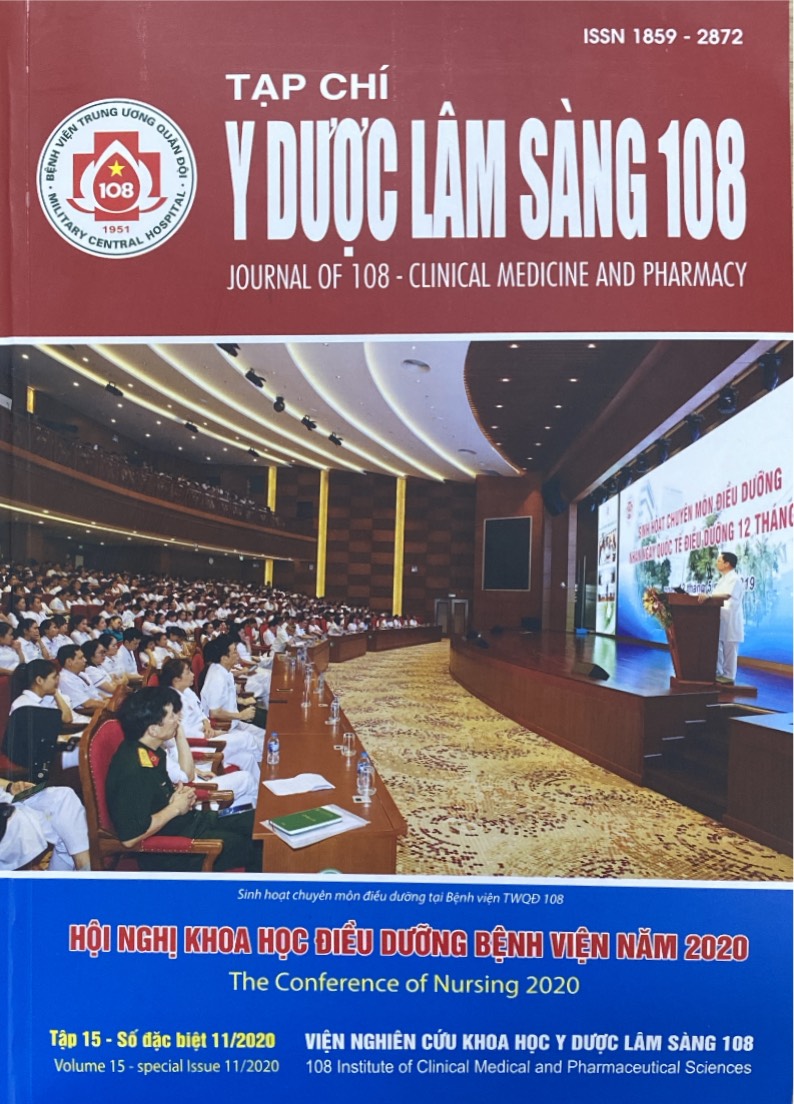Applicability of Clavien-Dindo score in monitoring patients after mini percutaneous nephrolithotomy
Main Article Content
Keywords
Abstract
Objective: To evaluate applicability of modified Clavien Dindo score in monitoring patients after mini percutaneous nephrolithotomy (mini-PCNL). Subject and method: A prospective study of 72 kidney stones case treated by mini-PCNL management at 108 Military Central Hospital from Jan 2020 to April 2020. The modified Clavien classfication system, which classfies the perioperative complications into 5 grade, was applied. Result: 51 males (70.8%) and 21 females (29.2%) with the average age of 52.2 ± 10.2 (range from 30 to 80 years old). Stone site: Renal pelvis: (22.2%), lower calyx (50%), pelvis and 1 calyx: (26.4%), Average operative time: 87.5 ± 21.7 minutes (40 - 140). Laser lithotripsy and stone removal were successful in 100% cases. The rate of postoperative early complication was 12.5% (fever post operated). The mean of hospital stay: 6.8 ± 3.6 days (5 ÷ 10). Nephrostomy tube removal after: 2.0 ± 0.76 days (2 ÷ 5). No severe complications. Conclusion: Using the modified Clavien Dindo score in evaluating surgical complications helps to statistically report symtemic complications, helping the patient’s monitoring of nursing be effective.
Article Details
References
2. Nguyễn Đạo Thuấn, Vũ Văn Ty, Nguyễn Văn Hiệp và cộng sự (2005) Kết quả lấy sỏi thận, niệu quản nội soi qua da trên 622 bệnh nhân. Tạp chí Y học Việt Nam, tr. 85-91.
3. Vũ Nguyễn Khải Ca (2009) Nghiên cứu ứng dụng phương pháp tán sỏi qua da trong điều trị sỏi thận tại Bệnh viện Việt Đức.
4. Clavien PA, Barkun J, Michelle L, Oliveira ML, Vauthey JN & Dindo D (2009) The Clavien-Dindo classification of surgical complications: Five-year experience. Annals of Surgery 250(2): 187-196.
5. Dindo D, Clavien PA (2008) What is a surgical complication?. World J Surg 32(6): 939-941.
6. Dindo D, Clavien PA (2010) Quanlity assessment in surgery: Mission impossible?. BioMed Central Switzerland, published by University Hospital Zurich.
7. Endre H, Munim Khan A, Tibor Fl, Csaba T, Morshed AS (2004) Endoscopic management of pediatric urolithiasis in a developing country. Jan Pediatric urology: 159-162.
8. Tefekli A, Ali Karadag M, Tepeler K, Sari E, Berberoglu Y, Baykal M et al (2008) Classification of percutaneous nephrolithotomy complications using the modified Clavien grading system: Looking for a standard. Eur Urol 53: 184-190.
9. Rosette J, Assimos D, Desai M, Gutierrez J, Lingeman J, Scarpaet R et al (2011) The clinical research office of the endourological society percutaneous nephrolithotomy global study: Indications, complications, and outcomes in 5803 patients. J Endourol 25: 11-17.
10. Maurice Stephan Michel, Lutz Trojan, Jens Jochen Rassweiler (2017) Complications in Percutaneous Nephrolithotomy. Europea Urology 51(2007): 899-899.
 ISSN: 1859 - 2872
ISSN: 1859 - 2872
